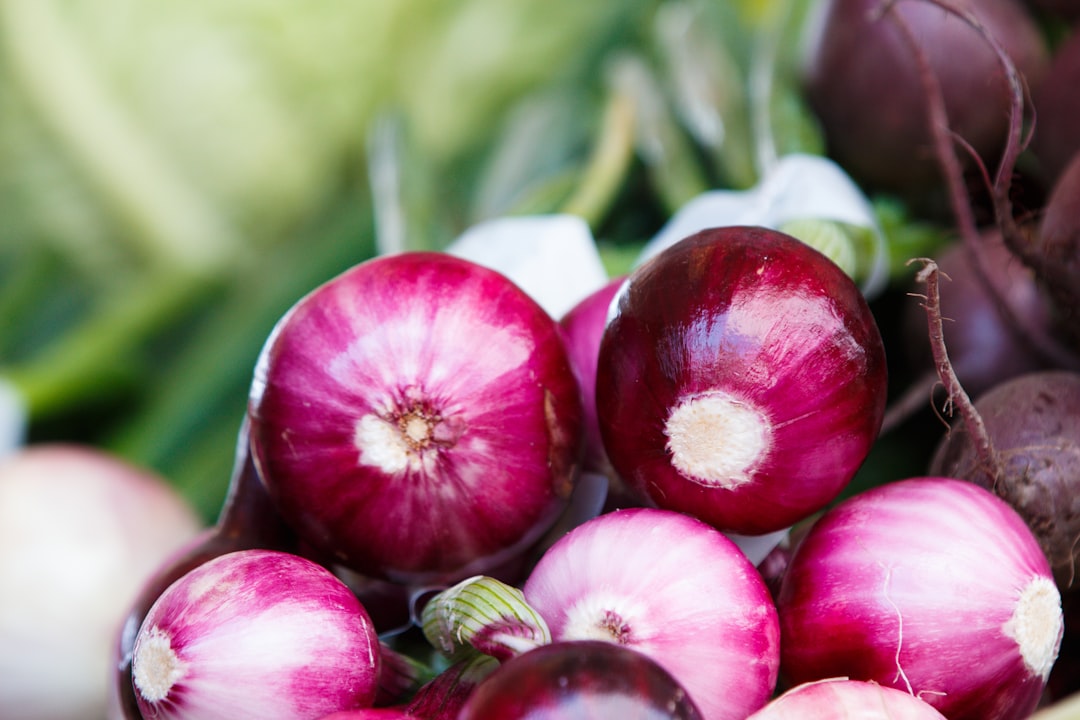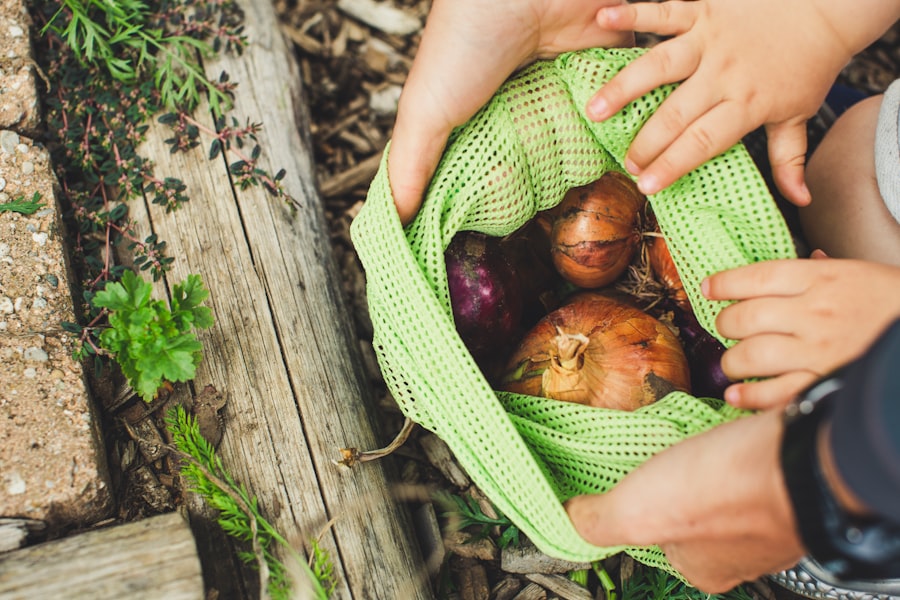When to Harvest Onions: Picking Time

Onions are a staple in many cuisines around the world and are used in a wide variety of dishes. Whether you are a home gardener or a commercial farmer, understanding the onion life cycle and knowing when to harvest them is crucial for optimal results. Harvesting onions at the right time ensures that they are flavorful, have a good shelf life, and are ready for consumption or further processing.
Key Takeaways
- Understanding the life cycle of onions is crucial for successful harvesting.
- Climate and soil are important factors that affect onion harvesting time.
- Physical cues such as yellowing leaves and a soft neck indicate that onions are ready to be harvested.
- The best time of day to harvest onions is in the morning when the soil is dry.
- Tools such as a digging fork and techniques such as gently lifting the onions from the soil are important for harvesting onions.
Understanding the Life Cycle of Onions: Key to Harvesting
To effectively harvest onions, it is important to understand the different stages of their growth. Onions go through several stages from planting to maturity. These stages include seed germination, bulb formation, leaf growth, and bulb enlargement. Each stage has specific requirements in terms of temperature, moisture, and nutrients.
Determining the maturity of onions is essential for harvesting them at the right time. Onions are typically ready for harvest when their tops start to fall over and turn yellow or brown. The outer skin of the onion bulb should also be dry and papery. Harvesting too early can result in small bulbs with less flavor, while harvesting too late can lead to bulbs that are prone to rotting.
Factors Affecting Onion Harvesting Time: Climate and Soil
The climate and soil conditions play a significant role in determining the maturity of onions. Onions thrive in cool weather with temperatures ranging from 55°F to 75°F (13°C to 24°C). They require well-drained soil with a pH level between 6.0 and 7.0.
The length of the growing season also affects onion maturity. Onions grown in regions with shorter growing seasons may need to be harvested earlier than those grown in regions with longer growing seasons. Additionally, excessive heat or cold can delay onion maturity or cause premature bolting.
Soil fertility is another important factor to consider. Onions require adequate levels of nitrogen, phosphorus, and potassium for optimal growth and bulb development. Conducting a soil test before planting can help determine if any amendments are needed to ensure proper onion development.
Signs that Onions are Ready to be Harvested: Physical Cues
| Physical Cues | Description |
|---|---|
| Yellowing of leaves | The leaves of the onion plant will start to turn yellow and fall over. |
| Bulb size | The onion bulb will have reached its full size and will no longer grow larger. |
| Firmness of bulb | The onion bulb will feel firm and solid when gently squeezed. |
| Drying of outer skin | The outer skin of the onion bulb will start to dry and become papery. |
| Bending of stems | The stems of the onion plant will start to bend over and dry out. |
There are several physical cues that indicate when onions are ready to be harvested. As mentioned earlier, the tops of the onions will start to fall over and turn yellow or brown. This is a natural process as the onion plant redirects its energy from leaf growth to bulb development.
The outer skin of the onion bulb should also be dry and papery. Gently squeeze the bulb to check for firmness. If the bulb feels soft or spongy, it is not yet mature and should be left in the ground for a little longer. Onions that are ready for harvest will have a firm bulb.
Another cue to look for is the size of the onion bulb. Depending on the variety, mature onions can range in size from small to large. However, it is important to note that larger bulbs tend to have a stronger flavor, while smaller bulbs are milder in taste.
Best Time of Day to Harvest Onions: Timing is Everything
Timing is crucial when it comes to harvesting onions. The best time of day to harvest onions is in the morning when the temperatures are cooler. This helps preserve the quality and flavor of the onions. Harvesting in the afternoon when temperatures are higher can cause the onions to become limp and lose moisture.
It is also important to avoid harvesting onions when they are wet from rain or dew. Wet onions are more prone to rotting during storage. If rain is in the forecast, it is best to wait until the onions have dried before harvesting them.
How to Harvest Onions: Tools and Techniques

To harvest onions, you will need a few basic tools such as a garden fork or shovel, a pair of pruning shears or scissors, and a basket or crate for collecting the harvested onions. Start by loosening the soil around the onions using the garden fork or shovel. Be careful not to damage the bulbs in the process.
Once the soil is loosened, gently lift the onions out of the ground by grasping the tops near the base and pulling upwards. Avoid pulling on the tops too forcefully as this can cause them to detach from the bulbs. If any onions are difficult to remove, use a garden fork or shovel to gently pry them out.
After harvesting, trim off the tops of the onions, leaving about an inch of stem attached to the bulb. This helps prevent moisture loss during storage. Place the harvested onions in a well-ventilated area to dry for a few days before storing or using them.
Preparing Onions for Harvest: Tips for Optimal Results
Proper preparation before harvesting can help ensure optimal results. One important step is to stop watering the onions a week or two before harvest. This allows the outer skin of the onion bulb to dry and cure, which improves their shelf life.
Removing any weeds or debris from around the onion plants also helps facilitate harvesting. Weeds can compete with onions for nutrients and moisture, affecting their growth and development. Clearing the area around the onion plants makes it easier to harvest without damaging the bulbs.
Storing Onions After Harvesting: Keeping them Fresh and Flavorful
Storing onions correctly after harvesting is essential for keeping them fresh and flavorful. Onions should be stored in a cool, dry, and well-ventilated area. The ideal temperature for onion storage is between 32°F and 40°F (0°C and 4°C). Avoid storing onions near fruits such as apples or pears, as they release ethylene gas which can cause onions to spoil faster.
It is important to store onions in a single layer rather than stacking them on top of each other. Stacking can cause the onions to bruise or rot. If you have a large quantity of onions, consider using mesh bags or wooden crates for storage. This allows for better air circulation and helps prevent moisture buildup.
Regularly check stored onions for any signs of spoilage or rotting. Remove any onions that show signs of decay to prevent it from spreading to the rest of the stored onions.
Harvesting Onions for Different Purposes: Culinary vs. Seed Production
The method of harvesting onions can vary depending on whether they are being harvested for culinary use or seed production. When harvesting onions for culinary use, the focus is on the bulb. The tops of the onions should be fully dry and the bulbs should be firm. Harvesting at this stage ensures that the onions have reached their maximum size and flavor.
On the other hand, when harvesting onions for seed production, the focus is on allowing the tops to fully mature and dry before harvesting. The tops should turn brown and dry out completely. Once the tops are dry, the onion plants can be uprooted and hung upside down in a well-ventilated area to allow the seeds to fully mature and dry.
Harvesting Onions in Bulk: Commercial Harvesting Techniques
Commercial onion harvesting often involves large-scale operations and requires specialized equipment. Mechanical harvesters are commonly used to lift and separate the onions from the soil. These machines have conveyor belts that transport the harvested onions into bins or trailers.
Once harvested, commercial onions are typically transported to a packing facility where they are sorted, cleaned, and packaged for distribution. The use of machinery allows for faster and more efficient harvesting, especially when dealing with large quantities of onions.
Troubleshooting Onion Harvesting Problems: Common Issues and Solutions
During onion harvesting, there can be several common problems that arise. One common issue is premature bolting, where the onion plant produces a flower stalk before the bulb has fully developed. This can be caused by stress factors such as temperature fluctuations or inadequate watering. To prevent premature bolting, ensure that onions are planted in the appropriate season and provide consistent moisture throughout their growth.
Another problem is onion rot, which can occur during storage if the onions were not properly cured or if they were damaged during harvesting. To prevent onion rot, ensure that the onions are fully dry before storing them and handle them with care to avoid bruising or damaging the bulbs.
Pests and diseases can also affect onion harvesting. Common pests include onion maggots and thrips, while diseases such as onion downy mildew and white rot can cause damage to the plants. Implementing proper pest and disease management practices, such as crop rotation and regular monitoring, can help prevent these issues.
Properly harvesting onions is essential for optimal flavor, shelf life, and overall quality. Understanding the onion life cycle, determining maturity, and considering factors such as climate and soil conditions are key to successful onion harvesting. By following the right techniques and using the appropriate tools, you can ensure a bountiful harvest of flavorful onions that can be enjoyed in a variety of culinary dishes or used for seed production.
If you’re wondering when to pick your onions, you might find this article from Lawn World helpful. It provides valuable insights and tips on the best time to harvest onions for optimal flavor and storage. Check out the article here for expert advice on onion harvesting and more.
FAQs
What is the best time to pick onions?
Onions are ready to be harvested when their tops start to dry and fall over. This usually happens in late summer or early fall, depending on when they were planted.
How do I know if my onions are ready to be picked?
You can tell if your onions are ready to be picked by checking the tops of the plants. When the tops start to dry and fall over, it is a sign that the onions are ready to be harvested.
What happens if I pick my onions too early?
If you pick your onions too early, they may not have fully developed and may not store well. It is best to wait until the tops of the plants start to dry and fall over before harvesting.
What happens if I leave my onions in the ground too long?
If you leave your onions in the ground too long, they may start to rot or sprout. It is best to harvest them when the tops start to dry and fall over.
How do I harvest my onions?
To harvest your onions, gently pull them out of the ground by the tops. Be careful not to damage the bulbs or bruise them.
What should I do with my onions after I harvest them?
After you harvest your onions, you should let them dry in a warm, dry place for a few days. Once they are dry, you can store them in a cool, dry place for several months.



